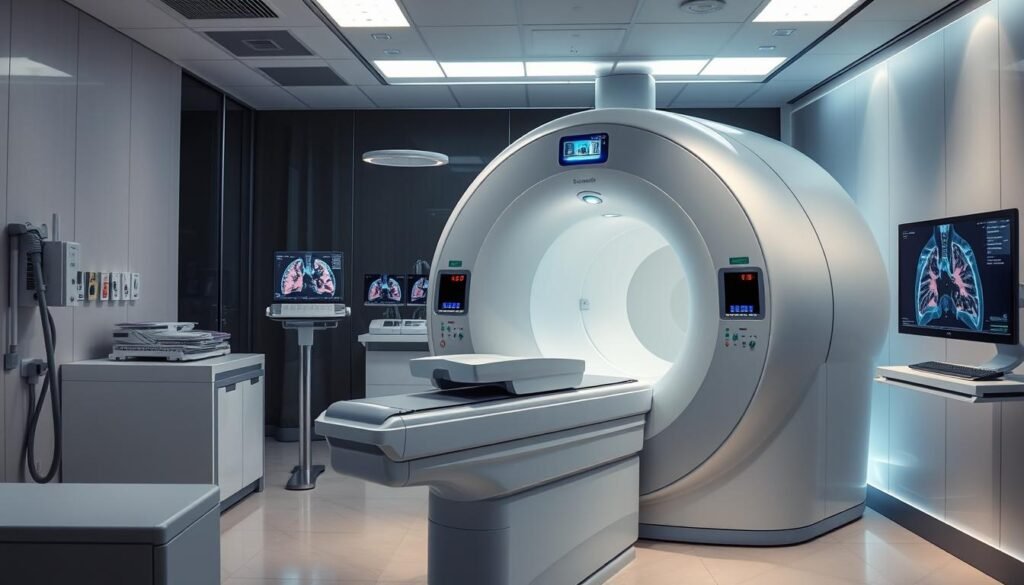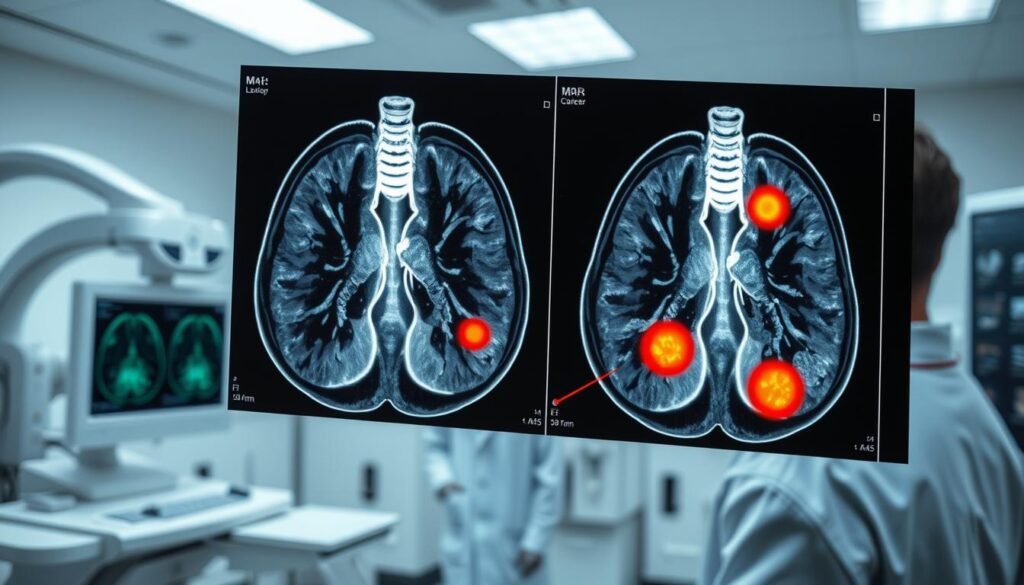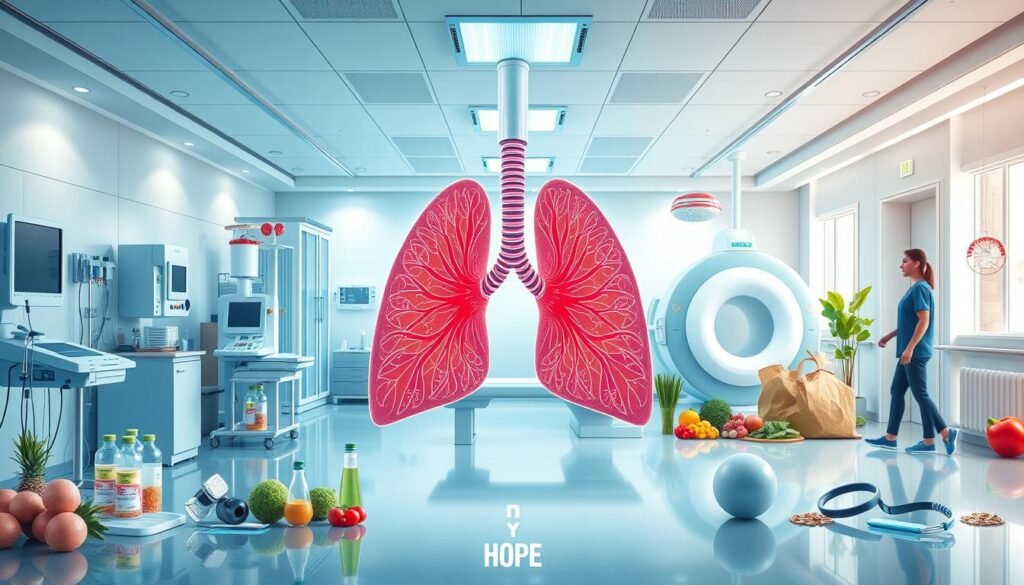Did you know that lung cancer screening rates in the U.S. are below 6%? This is the lowest among routine cancer screenings. Such a low rate shows we need more awareness about the importance of catching lung cancer early. MRIs play a key role in spotting lung cancer without surgery, especially for seeing if it has spread to important places like the brain and spinal cord. Knowing what happens during an MRI can help patients feel more prepared for early detection and treatment.
Key Takeaways
- MRI scans are essential for evaluating the extent of lung cancer.
- Screening is recommended for individuals aged 50-80 with a significant smoking history.
- Early detection through screening can reduce death rates by up to 20%.
- Knowledge of diagnostic procedures like MRI enhances patient understanding and anxiety reduction.
- Understanding the differences between various imaging methods aids in informed decision-making.
Understanding Lung Cancer Screening
Lung cancer screening is vital for people at high risk. It aims to spot early-stage lung cancer, improving treatment chances. A low-dose CT scan (LDCT) is mainly used. It cuts down on radiation compared to usual scans.
Older adults, especially heavy smokers or those with lung issue signs, should think about screening. Talking with doctors can help decide if it’s right for them, based on their health.
New MRI technology is changing how we find lung nodules, even tiny ones around 3-4 mm. Studies highlight MRI’s ability to spot these nodules accurately. This suggests MRIs might soon boost or even replace traditional screening.
| Method | Sensitivity (%) | Detection Rate (%) |
|---|---|---|
| Low-Dose CT Scan (LDCT) | Up to 95% | 97.0% |
| MRI (STIR TSE Sequences) | 90.1% | 82.5% |
| PET-CT | 76.7% | N/A |
MRI’s role in screening for lung cancer is growing. It’s good at telling non-cancerous from cancerous nodules. And it helps with TNM staging. These steps lead to better treatment plans and higher finding rates in at-risk groups. For more about lung cancer screening, check out this resource.
Who Should Consider Lung Cancer Screening?
Lung cancer screening is mainly for people at high risk. This includes older adults, aged 50 and above, who are current or former smokers. If you’ve smoked for 20 pack years or more, think about getting screened. A pack year means the number of pack smoked daily multiplied by smoking years.
Have you quit smoking in the last 15 years after heavy smoking? Then you might need screening. People treated for lung cancer over five years ago should also get checked again. Conditions like COPD, a family history of lung cancer, or being around asbestos up your risk too.
Doctors must look at these factors when talking about lung health. Lung cancer caused 18% of all cancer deaths in the U.S. in 2020. Early detection through screening is critical.
Considerations for candidates include:
- Age: 50 years and older
- Smoking history: 20 pack years or longer
- Recent ex-smokers: Quit within the last 15 years
- Treatment history: Those treated for lung cancer over five years ago
- Other risk factors: COPD, family lung cancer history, asbestos exposure
Screening for lung cancer is key to finding it early. This can greatly improve how well treatments work and increase survival chances.
Preparing for an MRI of Lung Cancer
Getting ready for a lung cancer MRI is crucial for a successful test. You’ll start by talking about your health history. This includes any lung problems, past cancer, current meds, and recent colds or flus. This info helps doctors check for risks and make plans.
Discussing Your Medical History
When talking about your medical past, tell your doctor about any lung issues or treatments you’ve had. This important info helps in managing your MRI properly. It makes sure your MRI is safe and right for you.
Precautions Before the Scan
Before your MRI, you need to take some steps. Make sure to remove any metal items like jewelry. This is because metal messes with the MRI images. You should also wear comfy clothes without metal. Doing these things helps get the best pictures and makes your test go smoothly.
| Preparation Steps | Description |
|---|---|
| Medical History Review | Discuss any respiratory issues, past cancer diagnoses, and medications. |
| Address Recent Illness | Inform the healthcare provider of any recent respiratory infections. |
| Remove Metallic Items | Take off jewelry and accessories that may affect the MRI. |
| Wear Comfortable Clothing | Opt for clothes without metal to ensure a smooth scanning process. |
What Happens During the MRI Scan?
When getting an MRI scan for lung cancer, patients lie on a table that moves into a machine. This machine is large and shaped like a donut. It’s made for detailed chest images. The scan uses magnets and radio waves, not harmful radiation. So, it’s safe to have more than one scan.
The Imaging Process
The aim is to get clear lung images. The machine uses special settings for the chest. It takes pictures that let doctors see any lung issues clearly. During the scan, patients might hear noises and have to hold their breath sometimes. If needed, a dye called gadolinium can make the pictures clearer. This dye is mostly safe.
Duration of the Procedure
An MRI scan usually takes under 30 minutes. This includes getting ready and any adjustments. While some scans take longer, chest MRIs are quick. It’s important to stay still during the scan. Patients who find this hard may get medicine to relax. And, for those who don’t like tight spaces, an open MRI option is available.

Risks and Benefits of Lung Cancer Screening
Lung cancer screening helps spot the disease early, raising survival chances. It has many benefits but also risks. Screening, mainly with low-dose CT scans, greatly lowers death rates from lung cancer. Studies show that over half of lung cancers found during screening are at an early stage. Early detection makes these cases easier to treat.
Assessing Radiation Exposure
The radiation from lung cancer scans, like CT screenings, equals the natural background radiation we get over six months. Even though the amount is small, both patients and doctors think about it. They consider the risks and benefits of screening together.
Understanding False Positives and Overdiagnosis
False positives are a big worry in lung cancer screening. About 12-14% of first screenings have false positives, causing stress and more tests. But this number falls to around 6% for yearly screenings. With better MRI scans, false positives and overdiagnosis are less common now. About 6% of first tests find something unexpected, dropping to 2% for later tests. If something odd is found, doctors may suggest more scans or a biopsy.
| Aspect | Initial Screening | Annual Follow-Up |
|---|---|---|
| False Positive Rate | 12-14% | 6% |
| Incidental Findings | 6% | 2% |
| Radiation Exposure Equivalent | 6 months natural background radiation | 6 months natural background radiation |
In summary, lung cancer screening, like with low-dose CT scans, improves early detection significantly. Yet, it’s key to know about radiation and the chance of false positives. Understanding these helps patients make informed choices about their care.
Interpreting Your MRI Results
Understanding your MRI results is crucial when checking for lung issues. These results help decide the next steps in treating lung cancer. They also make your health situation clearer. MRI outcomes are usually positive, negative, or indeterminate, each leading to different actions.
Possible Outcomes: Positive, Negative, and Indeterminate Results
A positive result means a lung nodule or another problem was found. This usually requires more tests or even biopsies. The goal is to see if these findings suggest cancer.
A negative result means no lung problems were found. This news is often a relief. It suggests good lung health. Yet, staying vigilant with regular checks is key to catch any future issues early.
An indeterminate result means the findings aren’t clear-cut. They’re hard to label as harmless or harmful. This could mean more tests over time. Discussing these results with a healthcare provider helps understand what they mean.

Follow-Up After the MRI Scan
After you get an MRI scan for lung cancer screening, it’s important to know what comes next. The next steps depend on your MRI results. You might need more tests, like a biopsy or a PET scan, especially if they find any unusual nodules. Catching any issues early can help with getting better treatment options.
Next Steps Based on Results
The follow-up plan changes based on what the MRI shows. If the results are not normal or show possible problems, doctors might suggest:
- Biopsy to check the diagnosis.
- PET scan for a deeper look.
- Talking to a cancer specialist for treatment ideas.
If your results are normal, doctors usually recommend a yearly checkup to keep an eye on your lungs. Regular checks are key. They can catch any new changes early and help decide if more tests are needed.
Importance of Annual Screening
An annual lung cancer screening is a big part of taking care of your lungs long-term. The advice is to follow certain steps:
| Time Since Last Screening | Recommended Follow-Up |
|---|---|
| 0-2 years | CT scans and blood tests every 3 months |
| 2-5 years | CT scans and blood tests every 6 months |
| 5+ years | Yearly screenings |
Sticking to these guidelines is super important, especially for those who have had lung cancer before or are at higher risk. Keeping up with your check-ups shows you are serious about your lung health. It also improves your chances for a good outcome.
Lung Cancer Treatment Options
When lung cancer is found, many treatment paths are available. These depend on the cancer’s details. Treatments may include surgery, chemotherapy, radiation, immunotherapy, and targeted therapies. Knowing about oncological radiology is key. It helps see the tumor’s location and size clearly.
Understanding Oncological Radiology
Oncological radiology uses advanced imaging like MRI to plan treatment. This imaging checks the tumor’s changes and monitors treatment success. MRI, CT, and PET scans are vital. They diagnose lung cancer and find its stage. Stages 1 to 4 show how big or spread out the cancer is.
Surgical options for lung cancer vary based on the disease’s spread. These can include wedge resection to pneumonectomy. Radiation therapy might be used before or after surgery, often with chemotherapy. For the latest in imaging techniques and biomarkers, click here.

Chemotherapy is a key treatment, used alone or with radiation. Immunotherapy and targeted therapies work well for certain tumors. They tap into the cancer cells’ unique traits to help patients. Thanks to new technology in radiology, lung cancer treatments are becoming more tailored and effective.
| Treatment Type | Indication | Administration Method |
|---|---|---|
| Surgery | Localized tumors | Invasive procedure |
| Chemotherapy | Advanced-stage cancer | IV or oral meds |
| Radiation Therapy | Post-surgery or metastasis | External beam treatment |
| Immunotherapy | Unresectable tumors | IV infusion |
| Targeted Therapy | Specific cancer mutations | Oral or IV medications |
Importance of Early Detection in Lung Cancer
Finding lung cancer early is key to beating it. In the United States, lung cancer ranks second among all cancers and is the top cause of cancer deaths. Quick and early screening is vital for those at risk. Catching the disease early means patients can get better treatment, which greatly boosts their chances of survival.
How Screening Saves Lives
Screening, especially with LDCT scans, really saves lives. It spots lung issues much better than old x-rays. The American Cancer Society advises yearly scans for people 50 to 80 with a long history of smoking. Studies show these screenings can reduce death rates by up to 20%, highlighting their life-saving power.
Advancements in Lung Cancer Imaging
The way we look for lung cancer has gotten a lot better, thanks to new technology. Now, blood tests can find lung cancers sooner than old methods. These improvements help doctors tailor treatment to each person’s cancer. Plus, places like Loyola Medicine help make screenings affordable for more people, increasing early detection. To learn more about new blood testing for early cancer detection, check out this study.
Common Misconceptions About Lung Cancer Screening
It’s vital to know the truth about lung cancer screening if you’re thinking about it. Many lung cancer screening myths are out there, especially about MRI concerns. It’s essential to clear up these misconceptions about procedures. This can help you make better health choices.
Addressing Fears Surrounding MRIs
Some people worry about the safety and benefits of MRIs. They think the risk from radiation is too high compared to the benefits. But in truth, low-dose CT scans for lung cancer have much less radiation. They are safer for people at high risk.
Others are scared it might hurt or be uncomfortable. Knowing what to expect can ease these MRI concerns. The process is non-invasive and usually pain-free. If healthcare providers explain things well, patients will feel better and more informed.
Getting rid of these myths can get more people to screen for lung cancer. Right now, only about 3% of people who should get screened actually do. More awareness and education could mean more people get screened. This could save lives.
To find out more about lung cancer screening, visit this informative resource.
Resources for Lung Cancer Screening
Understanding lung cancer resources is key for those facing lung cancer screening. Support systems are there to help patients and their families. They offer emotional, social, and financial help to ease the journey.
Support Groups and Hotlines
Getting support is crucial when facing lung cancer screenings. Support groups provide comfort and a community feeling. Hotlines, like the one from the American Lung Association, give expert advice. This makes a big difference in emotional health.
Financial Assistance for Screening
Worrying about money is common when considering lung cancer screening. But, help is available. Financial assistance programs help with costs, making sure money is not a barrier. Insurance and Medicare often cover screening costs. For extra help, check out lung cancer screening resources.
| Resource Type | Description | Contact/Website |
|---|---|---|
| Support Groups | Emotional support and shared experiences for patients and families. | American Lung Association |
| Hotlines | Guidance and support for lung cancer screening inquiries. | American Lung Association |
| Financial Assistance Programs | Programs that help cover costs associated with lung cancer screenings. | American Lung Association |
Conclusion
Understanding lung cancer MRIs gives valuable insights for those getting diagnosed. It helps patients better understand non-invasive imaging. This knowledge is crucial for navigating through their healthcare journey.
Early detection plays a key role in treatment success. Therefore, regular screenings and talking with healthcare providers are key. These steps can greatly influence the outcome.
Recent studies show that advanced MRI techniques boost detection rates for different nodule sizes. Nodules over 4 mm are more likely to be cancerous. This underlines the need for early and reliable screening.
Thanks to ongoing progress in imaging tech, detection methods are getting better. These advancements also aim to set new standards for evaluating lung cancer.
Education for patients, access to resources, and new imaging innovations are vital in fight against lung cancer. By being proactive and careful, people can help improve health outcomes in this battle.